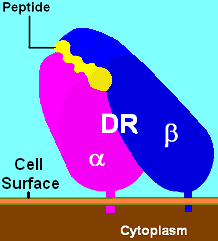Biology:HLA-DR18
From HandWiki

| |
major histocompatibility complex, class II, DR18
| |
| Haplotypes groups | DRA*01:DRB1*0302 DRA*01:DRB5*0303 |
| Structure (See HLA-DR) | |
| Identifiers | alpha *0101
|
| Symbol(s) | HLA-DRA[yes|permanent dead link|dead link}}] |
| EBI-HLA | DRA*0101 |
| Identifiers | beta 1 *0302 *0303
|
| Symbol(s) | HLA-DRB1[yes|permanent dead link|dead link}}] |
| EBI-HLA | DRB5*0302 |
| EBI-HLA | DRB1*0303 |
| Shared data | |
| Locus | chr.6 6p21.31 |
HLA-DR18 (DR18) is a HLA-DR serotype that recognizes the DRB1*0302 and *0303 gene products. Compared to DR17 which is found at high frequency in Western Europe, DR18 is found more in SE Europe and Central Asia.
Serology
| DRB1* | DR18 | DR3 | DR17 | Sample |
| allele | % | % | % | size (N) |
| 0302 | 66 | 24 | 3 | 317 |
| 0303 | 60 | 40 | 5 |
DR18 recognizes the DRB1*0302 and *0303, the thoroughness of recognition is fair, but better than DR3.
Disease associations
DR18 seropositivity is associated with rheumatoid polyarthritis[2]
DRB1*0302 is positively associated with juvenile diabetes,[3] nuclear helicase Mi-2 autoantibodies in inflammatory inclusion body myositis.[4]
Genetic Linkage
DR18 Haplotypes
| |||
| Serotypes | DRA | DRB1 | DRB3 |
|---|---|---|---|
| DR18(3)-DR52 | *0101 | *0302 | *0101 |
| DQA1 | DQB1 | DRB1 | |
| D18(3)-DQ2(2.5) | *0501 | *0201 | *0302 |
| HLA-A | HLA -B | DRB1 | |
| A33-B58-DR18(3) | *3301 | *5801 | *0302 |
HLA-DR18 is genetically linked to DR52 and HLA-DQ2 serotypes. These serotypes are the result of gene products from the HLA-DRB3* and HLA DQA1*0501 and HLA DQB1*0201 alleles.
References
- ↑ derived from IMGT/HLA
- ↑ "[Identification of HLA-DR alleles for susceptibility to rheumatoid polyarthritis in Senegal]". Dakar Med 42 (2): 111–3. 1997. PMID 9827131.
- ↑ "HLA class II allele frequencies in type 1A diabetes mellitus Slovak patients". Bratislavské Lekárske Listy 107 (3): 76–9. 2006. PMID 16796128.
- ↑ "An inflammatory, familial, inclusion body myositis with autoimmune features and a phenotype identical to sporadic inclusion body myositis. Studies in three families". Brain 120 ( Pt 4) (4): 653–661. 1997. doi:10.1093/brain/120.4.653. PMID 9153127.
 |

